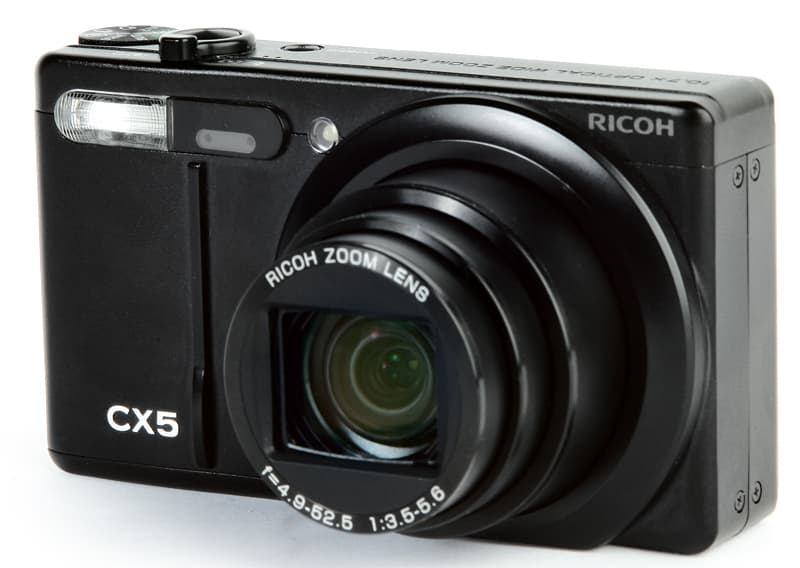Ricoh CX5 review – Introduction
Like Ricoh’s mid-level compact R series before it, the CX series maintains a steady and regular release interval. Since the beginning of 2004, Ricoh has announced a new model roughly once every six months, with the first CX released at the beginning of 2009. We are now on the fifth CX model and, like its predecessor, the Ricoh CX5 brings in a few refinements.
This time Ricoh has introduced a new hybrid AF system that combines a distance sensore with contrast detection AF. Ricoh claims a focusing speed of 0.2 seconds, which is twice as fast as that of the CX4.
Further to this, new super-resolution technology allows an expansion of the 28-300mm focal range to 600mm. Three new scene modes named ‘cooking’, ‘fireworks’ and ‘continuous golf swing’ take the total up to 14, and the Ricoh CX5 is now compatible with the wireless Eye-Fi memory card.
Build and Handling
 Like the CX4, the CX5 houses a 28-300mm (equivalent), 10.7x optical zoom in a 29.4mm-deep body. Its 10-million-pixel sensor is the same as that found in the CX3 and CX4, as is the 3in, 920,000-dot LCD screen, which is crisp and bright but shows smudges quickly and needs regular wipes.
Like the CX4, the CX5 houses a 28-300mm (equivalent), 10.7x optical zoom in a 29.4mm-deep body. Its 10-million-pixel sensor is the same as that found in the CX3 and CX4, as is the 3in, 920,000-dot LCD screen, which is crisp and bright but shows smudges quickly and needs regular wipes.
The CX5 has virtually no distinguishable exterior changes either, except for the built-in flash, which has been shifted further to the right to make space for the new hybrid AF sensor. Unfortunately, this increases the likelihood that the flash will be hidden behind the photographer’s hand. However, this also takes it further from the lens axis, which lessens the chances of redeye.
The zoom range takes just under two seconds to go from 28mm to 300mm, and the digital zoom reaches a staggering 2,880mm, though the quality of this type of zoom has always been poor and I would not advise using it. An 8-stop step zoom for the 28-300mm range is useful to achieve specific focal lengths.
DSLR users should feel at home with the CX5’s simple, sophisticated and classic design, although its fully automatic operation may frustrate them. That said, in use the CX5 is an interesting mixture of point-and-shoot simplicity and a vast number of bracketing options for white balance, colour and focus, manual tweaks such as exposure compensation and modes to control functions such as AF.
In fact, the CX5 features more AF modes than most DSLRs. Handily, the user can assign the function button to one of these controls, plus the adjust/ok button can be used to directly access ISO, white balance, exposure compensation, spot AE and AF, and image size.
Slick operation means there is virtually no shutter lag and images are processed quickly, even when bracketed over several exposures. Hybrid AF is responsive and snaps into focus in virtually any situation. It slows down in low-light but only slightly, helped by the AF assist light. In short, the CX5 handles really well.
Useful features from earlier models include a 1cm macro mode, 5fps over three seconds, and the ability to extract a still image from video footage when using the 120fps, 640×480-pixel VGA video mode.
Performance
 The CX5 has an impressive 28-300mm zoom range, boosted to 600mm using super-resolution technology. Image quality drops a little at 600mm, and a steady hand is needed
The CX5 has an impressive 28-300mm zoom range, boosted to 600mm using super-resolution technology. Image quality drops a little at 600mm, and a steady hand is needed
Like the two models before it, the CX5 impresses in many situations. Auto white balance and autoexposure give well-exposed images with punch and contrast at lower sensitivities. Image quality is good at ISO 100 and 200, but beyond this the 10-million-pixel sensor is lacking when compared to its competition.
Noise is apparent at ISO 400 and 800, and I would use ISO 1600 and 3200 only as a last resort. However, the CX5 still produces pleasant A4 prints from lower sensitivities before smudging of detail is apparent.
While including more scene modes is intended to make life simpler, the sheer volume may, in fact, leave many users bewildered. Night landscape multi-shot is useful, but landscape and vivid give results that are far too saturated. I find most of the scene modes are best avoided, sticking to the auto mode and bracketing for exposure and colour when the camera struggles.
Our Verdict
 Having been refined, the CX5 is, of course, the strongest CX model yet.
Having been refined, the CX5 is, of course, the strongest CX model yet.
But only minor refinements over the last few versions have resulted in a camera that may just be losing some ground on the competition, particularly in regards to image quality at ISO 400 and higher.






